
Psoriasis (also known as lichen psoriasis) is a non-communicable chronic and often recurrent skin disease.
Psoriasis, the symptoms of which determine the tendency of periarticular tissue damage, manifests itself in the form of scaly papules, and it is worth noting that this disease is one of the most common skin lesions that occurs at any age.
The etiology of this disease has not yet been fully investigated and proven, however, many dermatologists still agree that psoriasis is a disease directly related to genetic inherited pathologies.
Do not self-medicate. See a doctor at the first sign of the disease.
General description
Psoriasis is characterized by the duration and duration of its own course. Meanwhile, remissions lasting several months or years indicate its subsequent return and lifespan. Spontaneous cure of the disease is extremely rare.
If you try to define a specific category of people who are prone to develop psoriasis, the solution will not be clear. The fact that psoriasis works as a systemic process is not only in people who have actual immune system disorders, but also in those who have certain functional or morphological disorders that are related to the functions of various systems and organs.
Regarding the group of dermatoses, psoriasis is one of the most studied diseases in them. Meanwhile, none of the hypotheses that exist today can fully define the essence of this disease. Based on this, the problems related to its therapy and prevention are in the same precarious and acute situation as before. Depending on the period, different ideas were born about the origin of psoriasis. This, in turn, has led to the selection of a number of forms, all of which are based on the results of certain laboratory tests and clinical observations.
- The hereditary nature of the disease. This includes the presence of psoriasis, taking into account several generations in which cases of this disease have been observed accordingly. Incidentally, heredity is what is considered to be the main and reliable cause of the development of psoriasis (in this case, psoriasis increases due to different types of provocative factors).
- The metabolic nature of the disease. In this case, disorders of fat metabolism (i. e. , cholesterol metabolism), decreased morbidity during starvation, increased phosphorus in psoriasis, and so on.
- The viral nature of the disease. In this case, the concept of direct involvement of viral infection in the etiology of the disease under study was developed based on numerous and long-term clinical observations. Accordingly, for the same reason, the infectious (and viral) nature as the theory of the development of psoriasis is the oldest. Thus, the end of the 19th century was characterized by the development of very extensive groups of psoriatic-type formations that developed in the background of patients with diseases such as scarlet fever and influenza. The systemic nature of the actual lesion, its recurrent and prolonged course, the presence of a relationship with meteorological and heliophysical factors, and certain features in the development of rashes characteristic of psoriasis have also confirmed the infectious nature of the disease. disease. As for the present moment, there is now a search for viral agents through which the psoriatic process can be triggered.
- The endocrine nature of the disease. The theory of a direct relationship between the development of psoriasis and the endocrine (as well as metabolic) nature has recently been supported by many. Studies in patients with psoriasis have often revealed certain abnormalities of the endocrine scale that have confirmed the relevance of such a relationship. In particular, disorders related to the functional state of the gonads, effects caused by the menstrual cycle, pregnancy, childbirth and lactation, and pronounced changes in the pituitary-adrenal system in patients were highlighted.
- The neurogenic nature of the disease. This is because the disease occurs in the background of current nerve shock to the patient (more precisely after transmission). In about 30% of cases, the exacerbation of the disease is due to stress. In this case, patients reduce their ability to pass on the effects and consequences of stress later. However, the disorders they occur (asthenic, vegetative-vascular-visceral, vegetative-vascular-dystonic, and astenodepressive) in combination with neurotic reactions provoke or even exacerbate the development of the prevailing vicious circle.
Classification
As already mentioned, psoriasis acts as a chronic and recurrent disease. Any of its existing forms can be attributed to a variant of the classification for psoriasis in which there is a distribution of pustular or non-pustular psoriasis. In general, the classification is as follows:
- Pustular psoriasis
- generalized psoriasis;
- ring psoriasis;
- palmoplantar psoriasis (limb psoriasis, persistent palmoplantar pustulosis, barbera pustular psoriasis);
- chronic form of persistent acrodermatitis (plantar and psoriasis of the foot and palm);
- herpetiform psoriasis impetigo.
- Non-pustular psoriasis
- psoriasis vulgaris or psoriasis vulgaris, simple psoriasis (plaque, stable psoriasis in chronic form);
- psoriatic erythroderma (erythrodermic psoriasis).
Many authors insist that this classification should be supplemented, which is why the types or forms of psoriasis can be added in the following variations:
- seborrhea-like psoriasis (seborrhea psoriasis);
- Psoriasis napkin;
- drug-induced psoriasis;
- "Reversible psoriasis" (psoriasis of skin folds, bending surfaces).
Psoriasis: symptoms
The first symptom of psoriasis is a rash of miliary-type papules, characterized by a gradual increase in the periphery, while simultaneously transforming into nummular and lenticular papules and fusing together, resulting in plaques of different sizes. The development of psoriasis within the skin defines three main stages.
First phase
This stage is defined as a progressive stage caused by the formation of new formations (actually papules) on the skin and an increase in the size of the formations already on the skin. This is also associated with the development of redness around the lesions (such a border is called a peripheral growth zone). Plaque along the edges is not sensitive to exfoliation, while exfoliation, which acts as the final stage of inflammation, does not keep pace with the growth process of psoriasis formations.

Second stage
The second stage defines a stationary period in which no new elements appear, but the size of the elements in the form of existing plaques and papules does not change. In general, the appearance of papules can be completed within any stage, so the stationary period may be accompanied by the simultaneous appearance of military papules, lentils, and nummular papules. Explain what the three types of papules are listed. So nummular papules are elements of a rounded rash with a diameter of 15-20 mm (hence these papules are also called coin-shaped). Lenticular papules, on the other hand, are elements of a flat or convex, oval, or round-shaped rash that resembles a lens. And finally, the military papules, which are conical in shape and thus resemble hemp seeds. Basically, these papules are small in size, with the predominant area located near the hair follicles.
Third stage
This section is reversed (or regressive). Its main feature is that the rash gradually disappears and a pseudosclerotic-type whitish border develops around the foci themselves (defined as the Voronov rim). During this period, some patients may experience mild itching. As for subjective feelings, they are mostly insignificant or even completely absent.
The appearance of rashes can be observed in any area of the skin, but predominantly on the surface of the bends of the limbs, especially in the elbow and knee joints, in the region of the sacrum (here, especially the area along the edge of hair growth, defined as a "psoriatic crown"). . Psoriasis on the head, the symptoms of which, although determined by the severity of their own manifestation, do not lead to a change in the structure of the hair or its loss.
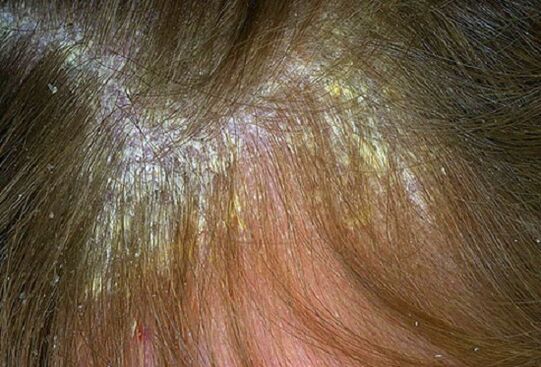
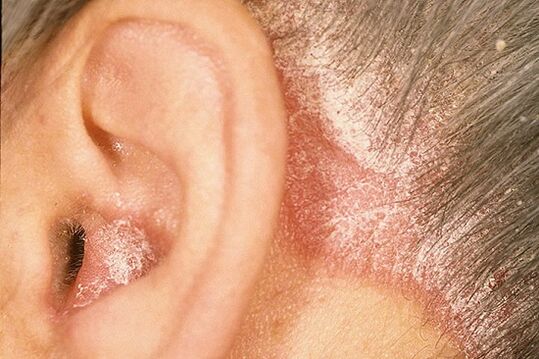
As for the concentration of plaques on the extensor surface of the knee and elbow joints, they often persist for a long time from the moment the rash usually disappears (this property defines them as "obligatory" plaques). Some patients are faced with the fact that skin folds in the lumbar-femoral region or in the mammary glands and axillary glands are affected, and often such a lesion can be isolated.
Irritated psoriasis
Active exposure to the skin results in the development of certain irritants, especially sunburn or special ointments, as well as other types of irritants that affect plaques with pre-existing progressive psoriasis. These plaques become more convex, their color changes to cherry red, and a hyperthermic belt forms within the surrounding area, causing the sharp boundaries to blur slightly. This belt gives a wrinkled appearance after the plaque is broken.
Spotted psoriasis
This form of the disease manifests itself in the form of a mild infiltration (the general definition of infiltration is the impregnation of tissues with one or another substance) from the elements of the rash. These, in turn, resemble spots (not papules). Spotted psoriasis usually develops in an acute manner and is characterized by similarity to toxidermia. Determining compliance with the course of the disease and its characteristic psoriasis triad is used as the main method of differentiating the disease.
Old psoriasis
This form of the disease can be considered as a symptom of severe infiltration from the plaque side, general cyanosis, hyperkeratotic or warty surface. Focuses of this type are particularly difficult to cure, and it is possible that they may be transformed into a malignant tumor in the future (this is rare, but unfortunately it is not necessary to rule out this possibility).
Seborrheic psoriasis
This form of psoriasis, as its name suggests, develops in patients who already have current seborrhea. The disease occurs on the scalp, in the area behind the cochlea, in the chest, in the area of nasolabial wrinkles, under the shoulder blade and in the shoulder blades. The resulting psoriasis skin scales are intensely saturated with sebum, causing them to stick together and remain within the surface of the plaque, allowing the disease to simulate the image characteristic of seborrheic eczema.
Palmar-plantar psoriasis
The disease can manifest in the form of common psoriatic plaques and papules, or in the form of hyperkeratotic formations that simulate calluses and calluses. In some cases, psoriasis of the hands, the symptoms of which in this case occur on the palms (or feet - by definition, the soles of the feet), is persistent, manifested in the form of increased thickening or keratinization. . The boundaries of this type of lesion are characterized by clarity, less frequently this form of psoriasis is limited to the appearance of ring-shaped exfoliation.
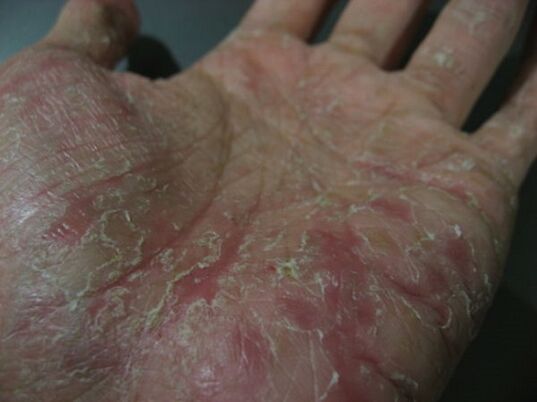
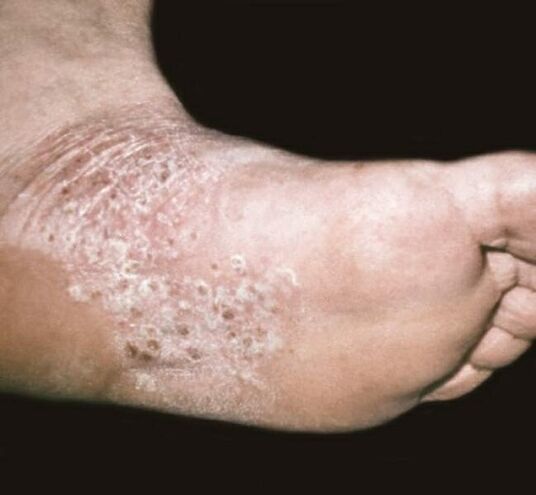
Exudative psoriasis
This form of psoriasis is characterized by increased secretion during the inflammatory reaction, which occurs during the progressive period of psoriasis. Upon reaching the surface of the papule, the secretions saturated the accumulation of scales, thereby forming crust-like formations out of them. These elements are secondary, they are defined as flaky bark, the color of these elements is yellowish. After removal, they reach a slightly bleeding and weeping surface. The scaly crust, when dried and layered, often forms a massive conglomerate reminiscent of oyster peel (already called rupioid psoriasis).
Guttate psoriasis
Guttate psoriasis, the symptoms of which are sudden, is characterized by the formation of multiple patches on the skin. The disease is most commonly diagnosed in patients between the ages of 8 and 16 years. Streptococcal infection often acts as a precursor to teardrop psoriasis.
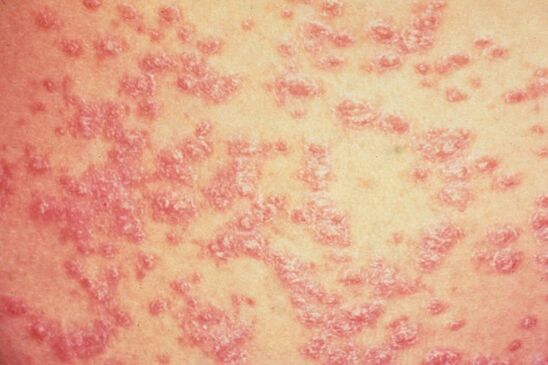
Psoriasis nails
Nail psoriasis, the symptoms of which provide for the isolation of this type of psoriasis in three main forms, can be atrophic, punctate, or hypertrophic, depending on the degree of nail damage.
The formation of punctate depressions on the nail plates, which can also be compared to the surface of the thimble, is considered to be an exact lesion. Manifestation of this form of psoriasis is possible in a slightly different variant that is similar in character to onychomycosis. In this case, within the free edge, the nail plate changes color, becomes dull, and tends to disintegrate without much effort. The inflammatory boundary at the periphery of the area of the affected nail plate is defined as a sign to distinguish psoriasis. It appears as the edge of the papula inside the nail bed, which is visible through the nail plate.
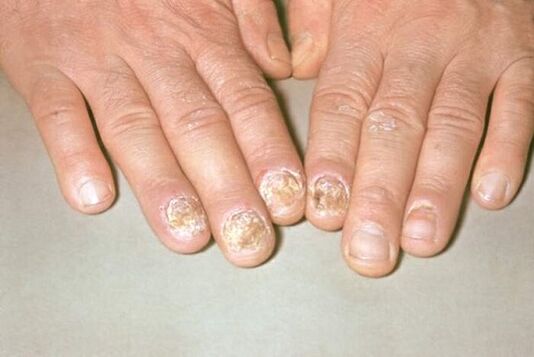
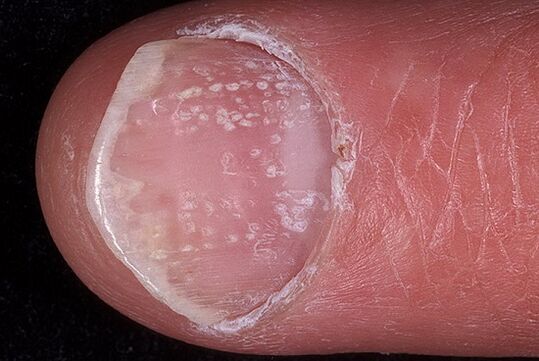
Psoriatic arthritis
Psoriasis is an arthritis characterized by infiltration of the periarticular tissues with concomitant damage to the joints, primarily affecting the interphalangeal joints. Meanwhile, the involvement of large joints in the pathological process is not ruled out, and the joints and joints of the sacroiliac spine are extremely rarely at risk.
It is important to note that psoriatic arthritis, unlike other types of arthritis (which in the general definition means inflammation of the joints), develops in the background of pre-existing psoriasis rashes in the patient, often in combination with nail damage. . In addition, it is important to note that the development of this type of arthritis is associated with an exacerbation of intradermal psoriasis, which in most cases is exudative.
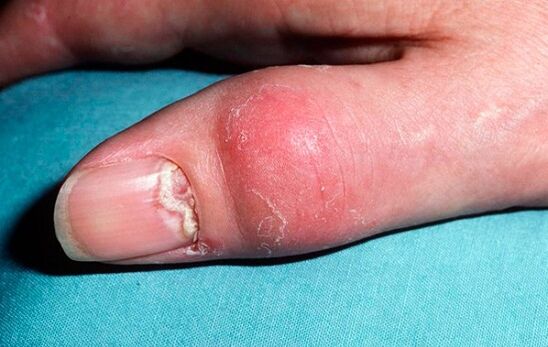
Irrational treatment of the disease during the period of progression is often accompanied by a non-specific reaction of the body. It is toxic-allergic in nature and consists of the appearance of redness in areas not affected by psoriatic plaques, this redness, when fused, completely affects the skin. This process is combined with an elevated temperature (up to 39 degrees) as well as an increase in lymph nodes, a feeling of skin tightness, a burning and itching sensation. In frequent cases, severe peeling, thickening and peeling of the nail plates and hair loss also occur. This picture already indicates the importance of psoriatic erythroderma. Erythroderma ends with the restoration of the traditional version of the course of psoriasis.
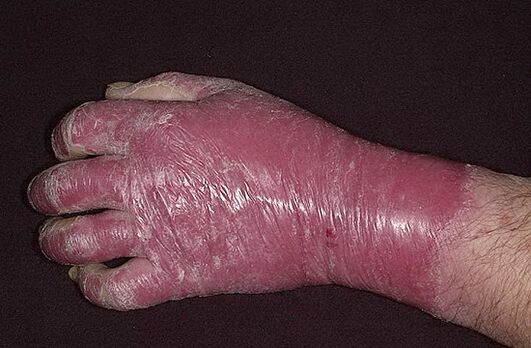
In general, recurrence of the disease occurs in the autumn-winter as well as in the spring-summer periods, which is an important factor to consider, including when prescribing the necessary treatment.
Psoriasis treatment
Prior to prescribing treatment, a thorough examination of the patient is performed and the specific measures are based on the stage of the disease, its clinical variability, the general condition of the patient, the presence of co-morbidities, the seasonality of the disease, etc. the fastest, yet uncomplicated forms of psoriasis have a favorable treatment result with a short course and limited manifestations. In general, treating psoriasis is a fairly labor-intensive process and in most cases no complete cure can be achieved - the disease simply regresses (i. e. , an asymptomatic period begins), which, however, is also a positive outcome for him.
The main goal of treatment was defined as the greatest possible reduction in symptoms by supplementing preventive measures.
First, psoriasis prescribes a diet in which foods that cause the disease to worsen (spicy foods, chocolate, alcoholic beverages) are excluded from the diet. The restriction applies to smoked meats, honey, fried and fatty foods, etc. consumption. During the period of exacerbation of the disease, it is recommended to consume more fruits and vegetables (except for reds: apples, tomatoes, cherries, etc. ), fish and lean meat (cooked).
The course of psoriasis has a beneficial effect on its treatment in health resort settings. Due to the special sensitivity of the skin of patients with psoriasis, it is recommended to avoid sun exposure during the 11-16 hour period.
As for the pharmacological treatment of psoriasis, it is based on the use of several methods. These are, in particular, external agents (creams, ointments, etc. ), systemic treatment agents (injections, tablets, etc. ) and methods such as phytochemotherapy (phytotherapy), physiotherapy, etc. external treatment methods. The most commonly used drugs were:
- Salicylic ointment. It ensures the softening of the scales that have formed, which in turn allows them to be eliminated early, along with better absorption of other types of drugs. This ointment (0, 5% or 5%) is applied in a thin layer 1-2 times a day to the affected areas of the skin. An important feature of the application is that a smaller amount of ointment is used with a significant inflammatory nature (i. e. , the more pronounced the inflammation in its manifestation, the less ointment is used for it). The salicylic acid that forms the basis of the drug is also found in many other ointments used to treat psoriasis.
- Sulfur tar ointment (5 or 10%). The use of this ointment reduces the inflammatory processes affecting the skin. Contraindications to its use are exudative psoriasis (i. e. , psoriasis accompanied by crying bark and scales). You should not apply this ointment to the skin of the face. Tar shampoos are used to treat psoriasis of the scalp.
- Naphthalene ointment. It is used to treat the regressive and stationary stages of the disease. Exacerbation or progression of psoriasis determines the inadmissibility of the treatment. The ointment reduces intense itching and inflammation. 5% or 10% ointment is used.
- Glucocorticosteroid drugs. Their use reduces the intensity of inflammation. It is used only for short courses under the supervision of a mandatory professional.
- Ointments containing vitamin D. Such ointments have an anti-inflammatory effect while improving the course of the disease.
As for systemic treatment, it is strictly selected individually and only by the treating physician. As already mentioned, this includes various tablets, injections, etc. means the use of.
Phytochemotherapy, as a way to treat psoriasis, consists of ultraviolet radiation from the affected skin areas. To do this, a special type of installation is used that irradiates such areas without affecting healthy skin.
In general, the treatment of psoriasis may involve a variety of regimens implemented in practice, but none of these are generally accepted due to differences in their course and specificity, so the efficacy of either regimen cannot be determined equally in all patients. We repeat that the treatment of the disease is carried out on a strictly individual basis, under the constant supervision of the attending physician.
If symptoms suggestive of psoriasis occur, consult a dermatologist and infectious disease specialist.























